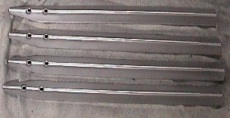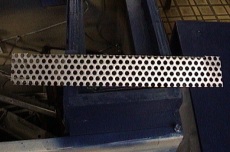Clay’s guide has you test the TIP42 by putting the red lead on the metal tab and then getting the reading from each of the legs. Well, as much as I use and like Clay’s guides, this is a mistake. The TIP42 transistor is unusual in its configuration. Most transistors are collector, base, emitter. However, the TIP42 is base, emitter, collector. Thus, to get a correct reading on these transistors, you must put the red lead on the right leg and then get a reading from the other two. Anyway, before finding out this information, I actually installed the transistor with the legs crossed, to see if this would help. Well, it did cause the lights to stay on all of the time.
With this information in hand, I then installed the correct transistor (TIP42). But, the lights still did not work. So, I went ahead and installed a new pre-driver transistor and a new 7408 chip. I put the board back in the game, and the column still did not work. Now I was really frustrated. I went over my work and here was the problem. The big resistor was not soldered well enough to make contact with the trace that leads to the TIP42. However, when I would test it with the DMM, it had continuity. It seems that by putting pressure on the resistor lead, the pressure gave it enough contact to make it seem like it was connected. Ultimately, the board had enough burn damage that it wouldn’t hold the solder so I jumped a wire from the transistor to the resistor. Well, this worked. I finally had the column going. It was the first time I saw the blue Joker lights work. IMHO, they are some of the coolest looking inserts.
I learned a couple of lessons here. Number one, I learned that TIP42s are unusual in their pinout. Second, I learned to use very little pressure when testing components for continuity. Third, I learned that Ed at GPE is a great guy.
Problem #5: Three lights that were in the same column were stuck on. The three lights that were staying on were the three saucer lights (Ace of Clubs, Ace of spades, and Ace of Hearts). There were actually multiple problems causing this. First, the TIP42 transistor was bad. So, I replaced it along with the pre-driver transistor. I put the board back in the game and no luck. The lights were still stuck on. I then noticed that the diode for the Ace of Clubs was bad. You could visually see that it was cracked. I replaced the diode. However, when replacing it, I also made a boo-boo. The light for the Ace of Clubs actually goes up through the playfield rather than sitting below it and shining through an insert. It lights up a graphic that is on the upper left plastic. Well, the light socket was falling out of the hole. It needed something to hold it in place. I stapled the wires to the board to hold the light socket. Stapling was fine (that’s how the other lights are held in place). But, my staple was touching the socket and one of the lamp leads shorting it out. So, none of the lights would work. But, I didn’t notice it. I figured the problem must have been on the driver board. Yet, by using a logic probe, I knew that the driver board was pulsing like it should. I decided to test the row by manually grounding the row transistor. When I did this, smoke started coming from the Ace of Club lamp! Aha, that was where the problem was. I lifted the playfield and sure enough, there was the staple shorting the row. I removed the staple. But, by now, I had also blown out the TIP42. After replacing the TIP42 for a second time, the column of lights finally worked like it was supposed to. So, it seems that the original problem was caused by a bad diode which in turn burned out the transistor. Then I added to the fiasco with my poor stapling job.
Problem #6: Only one phrase of the speech would work. This was a frustrating fix. In fact, this whole driver board gave me fits. Here’s what I went through to fix the problem. First, I pushed the test button on the sound board to check the speech. All of the sounds and speech worked. So, that eliminated the sound board. This meant the problem must have been on the driver board. So, step two, go into the game diagnostics and do the solenoid test to see if the sound solenoids are working. The sound solenoids are #9-13 on the driver board. At first, the test fooled me because I did the test automatically. Thus, the game automatically fired each coil. When it would get to the sound “solenoids” the first sound was fine, the second sound was fine, and it sounded as if the third sound worked. I found out later that what I was hearing was still the second sound continuing to play. It sounded different the longer it played so I assumed that a third sound was playing. The fourth and fifth sounds were OK also. So, I’m stumped. The sound board tests OK and the sound transistors test OK. The problem must be in the connectors! So, I replace the pins on the driver board J9.



